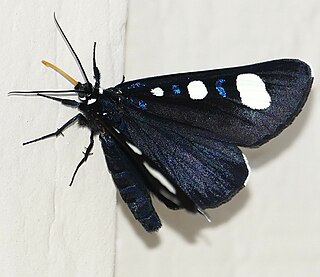
The Noctuidae, commonly known as owlet moths, cutworms or armyworms, are a family of moths. They are considered the most controversial family in the superfamily Noctuoidea because many of the clades are constantly changing, along with the other families of the Noctuoidea. It was considered the largest family in Lepidoptera for a long time, but after regrouping Lymantriinae, Catocalinae and Calpinae within the family Erebidae, the latter holds this title now. Currently, Noctuidae is the second largest family in Noctuoidea, with about 1,089 genera and 11,772 species. This classification is still contingent, as more changes continue to appear between Noctuidae and Erebidae.

Agaristinae is one of the larger subfamilies of moths in the family Noctuidae. The subfamily was erected by Jean Baptiste Boisduval in 1833. Its internal phylogeny and many genera are in need of review.
Acyclania is a genus of moths in the family Noctuidae first described by Paul Dognin in 1911. It was historically misclassified on multiple occasions, but in 2010 was determined to belong to the subfamily Agaristinae.
Chlanidophora albicancellata is a moth in the family Noctuidae first described by Hermann Burmeister in 1878. It can be found in Argentina; it was historically misclassified, but in 2010 was determined to belong to the subfamily Agaristinae.
Cyanohypsa is a genus of moths in the family Noctuidae. It contains the single species Cyanohypsa stefanellii, which is found in Argentina. Both the genus and species were first described by Eugenio Giacomelli in 1911; it was historically misclassified, but in 2010 was determined to belong to the subfamily Agaristinae.
Graphelysia is a genus of moths in the family Noctuidae. It contains only one species, Graphelysia strigillata, which can be found in south-eastern Peru; it was historically misclassified on multiple occasions, but in 2010 was determined to belong to the subfamily Agaristinae.
Gerra is a genus of moths in the family Noctuidae. The genus was erected by Francis Walker in 1865.
Alloasteropetes is a genus of moths of the family Noctuidae. The genus was erected by Yasunori Kishida and Yoshiyuki Machijima in 1994.
Cabralia is a genus of moths of the family Noctuidae, containing only a single species, Cabralia trifasciata; a second species (judsoni) was historically misclassified, but in 2010 was determined to belong to the genus Rhosus in the subfamily Agaristinae, leaving C. trifasciata as the sole remaining member of its genus.

Mimeusemia is a genus of moths of the family Noctuidae first described by Arthur Gardiner Butler in 1875. Species are found in Japan, India, Sri Lanka and Myanmar.

Oxythaphora is a genus of moths of the family Noctuidae, containing only a single species, Oxythaphora delta; it was historically misclassified on multiple occasions, but in 2010 was determined to belong to the subfamily Agaristinae. Both the genus and species were first described by Harrison Gray Dyar Jr. in 1917.

Rhosus is a genus of moths of the family Noctuidae. The genus was erected by Francis Walker in 1854.
Chlanidophora patagiata is a moth of the family Noctuidae first described by Carlos Berg in 1877. It is found in Patagonia; it was historically misclassified, but in 2010 was determined to belong to the subfamily Agaristinae.

Alypia ridingsii, the mountain forester or Ridings' forester, is a moth of the family Noctuidae. The species was first described by Augustus Radcliffe Grote in 1864. It is found in North America as far east as the eastern edge of the Rocky Mountains in Colorado. It is also found in Arizona, Utah, all of California and northward into Oregon, Idaho, Washington, British Columbia and Alaska
Diarsia dimorpha is a moth of the family Noctuidae. It is endemic to Luzon and has also been found in Borneo.

Alypia mariposa, the mariposa forester, is a moth of the family Noctuidae. The species was first described by Augustus Radcliffe Grote and Coleman Townsend Robinson in 1868. It is found in Coast Ranges and Sierra foothills of California, from Kern and San Luis Obispo counties in the south to Placer County in the north.
Acyclania schadei is a moth of the family Noctuidae first described by William Schaus in 1927. It is found in Paraguay. It was historically misclassified, but in 2010 was determined to belong to the subfamily Agaristinae.
Acyclania tenebrosa is a moth of the family Noctuidae first described by Paul Dognin in 1911. It is found in Argentina; it was historically misclassified, but in 2010 was determined to belong to the subfamily Agaristinae.

Alypiodes geronimo is a moth in the family Noctuidae. first described by William Barnes in 1900. It is found in North America and parts of Mexico.

Alypiodes flavilinguis is a species of moth in the family Noctuidae, first described by Augustus Radcliffe Grote in 1883. Its name has been lifted as a synonymy of Alypiodes bimaculata in 2021. It can be found in New Mexico, Arizona, and Texas.








